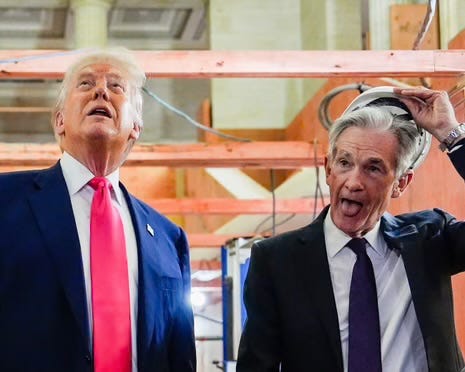Trump vs. Powell: A Clash Over the Federal Reserve’s Costly Renovation
On July 24, 2025, President Donald Trump’s tour of the Federal Reserve’s headquarters in Washington, D.C., turned into a heated public showdown with Fed Chair Jerome Powell. The visit, meant to inspect the ongoing renovation of the central bank’s historic buildings, instead spotlighted a $2.5 billion project that Trump decried as a wasteful misuse of funds.
This confrontation not only exposed the personal rift between the two men but also ignited a broader debate about the Federal Reserve’s priorities, its role in fueling inflation, and its accountability to the American people.
The Renovation Project: A Ballooning Price Tag
The Federal Reserve’s renovation project targets two key buildings: the Marriner S. Eccles Federal Reserve Board Building and the 1951 Constitution Avenue Building. Launched in 2017, the effort aims to modernize aging infrastructure, consolidate operations, and enhance security. But what began with a $1.9 billion budget has spiraled to $2.5 billion by 2025—a 30% increase that has fueled outrage.
-Cost Overruns: The Fed blames the hike on unexpected challenges, like asbestos removal and rising construction costs driven by inflation. Yet, critics see it as proof of mismanagement.
-Timeline: Completion remains years away, with no firm date set, prolonging the drain on resources.
-Trump’s Take: During the tour, Trump claimed the total cost could hit $3.1 billion, a figure Powell disputed, pegging it at $2.5 billion and attributing the higher number to a separate 2021 refurbishment.
For many, this $2.5 billion price tag is an extravagant waste, especially for an institution that doesn’t generate revenue like a business. Taxpayers and fiscal watchdogs argue the money could better serve struggling Americans rather than fund what some call a “palace” for unelected bureaucrats.
The Irony: The Fed’s Role in Inflation
The Federal Reserve’s mission includes controlling inflation, yet its own project mirrors the very excess it’s meant to curb. This irony deepens when you consider how the Fed’s policies, particularly through fractional reserve banking, contribute to rising prices.
Fractional Reserve Banking Explained
-How It Works: Banks must keep only a fraction of deposits in reserve (say, 10%), lending out the rest. When those loans are deposited elsewhere, the cycle repeats, creating new money with each step.
-Money Out of Thin Air: A $1,000 deposit can balloon into $10,000 in the system, amplifying the money supply without physical cash being printed.
-Inflation Link: If unchecked, this expansion fuels inflation, eroding the dollar’s value.
The Fed oversees this system, tweaking reserve requirements and interest rates to balance growth and stability. Yet, as consumer prices climbed 2.7% year-over-year in June 2025, critics question why the Fed isn’t reining in its own spending instead of splurging on renovations. An institution tasked with price stability overseeing a $2.5 billion boondoggle feels like a slap in the face to Americans grappling with higher costs.
Trump vs. Powell: A Power Struggle
The tour’s flashpoint came when Trump grilled Powell over the costs, reigniting their long-standing feud. Trump has long criticized Powell, especially over interest rates, and the renovation gave him fresh ammunition.
-Firing Powell?: Trump has mused about ousting Powell, hinting the cost overruns might justify it. Legally, he can remove a Fed governor “for cause” (e.g., misconduct), but he lacks the political clout—or perhaps the will—to push it through against likely backlash and legal hurdles.
-Powell’s Defiance: Powell shot back, insisting he won’t step down before his term ends in May 2026. He argued the renovations are essential, but his claim of immunity is shaky—while the law protects his tenure, it’s not absolute.
This standoff underscores Trump’s frustration with an independent Fed he can’t fully control, a tension that’s simmered since his first term.
Who Controls the Fed?
The Federal Reserve’s structure adds fuel to the fire. It’s a hybrid entity: its Board of Governors is appointed by the president and confirmed by the Senate, but its 12 regional banks are owned by private member banks. This setup gives private interests significant sway, rankling those who believe monetary policy should answer to elected officials.
-Current System: The Fed’s independence shields it from political whims, letting it prioritize data over populism.
-Critics’ View: Trump and others argue this autonomy hands too much power to unelected elites, unaccountable to voters. They want Congress or the White House to take the reins.
The renovation debacle amplifies this critique. If private banks influence the Fed, why isn’t it more frugal? A $2.5 billion project suggests a disconnect from public needs, bolstering calls for reform.
Inflation’s Toll on Us
The Fed’s policies ripple through our lives, and the renovation saga highlights a bitter reality: inflation, partly stoked by fractional reserve banking, shrinks our purchasing power. In June 2025, a dollar bought 2.7% less than a year prior, hitting essentials like groceries and gas hardest.
-Investment Trap: To outpace inflation, we turn to assets—stocks, real estate, gold. But gains are taxed as capital gains, often on nominal increases that don’t reflect real value after inflation.
-Losing Ground: Higher borrowing costs from Fed rate hikes, plus taxes, make it tough to stay ahead. Families save less, invest less, and feel the squeeze.
While the Fed renovates its headquarters, Americans struggle to keep up—a stark contrast that’s hard to ignore.
A Wasteful Symbol in a Struggling Economy
The Trump-Powell clash isn’t just personal; it’s a microcosm of bigger issues. The $2.5 billion renovation, with no end in sight, epitomizes perceived excess at the Fed. That it’s happening as inflation bites and the Fed’s own policies draw scrutiny makes it a potent symbol of misaligned priorities.
Trump may lack the muscle to fire Powell, and Powell may cling to his post, but the real losers are everyday Americans. The Fed should be tackling inflation, not building monuments to itself. Until it’s held accountable—ideally by elected leaders, not private banks—this disconnect will persist, leaving us to foot the bill, literally and figuratively, for their decisions.




